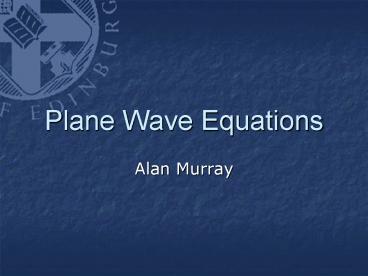Plane Wave Equations - PowerPoint PPT Presentation
1 / 25
Title:
Plane Wave Equations
Description:
Plane Wave Equations Alan Murray Maxwell's Equations Completed! What does this mean? Cross-breed Ampere and Faraday! Cross-breed Ampere and Faraday! – PowerPoint PPT presentation
Number of Views:349
Avg rating:3.0/5.0
Title: Plane Wave Equations
1
Plane Wave Equations
- Alan Murray
2
Maxwell's Equations Completed!
Gauss(D)
Gauss (B)
Ampere
Faraday
Displacement current (L)
3
What does this mean?
Faraday
a changing magnetic field causes an electric
field
Ampere
a changing electric field/flux causes an
magnetic field
Question If we put these together, can we get
electric and magnetic fields that, once created,
sustain one another?
4
Cross-breed Ampere and Faraday!
5
Cross-breed Ampere and Faraday!
Same equation as acquired for E
6
Now some simplifications
EY EY0sin(?t-ßx)
E (0,EY,0) only
Align y-axis with electric field and the x-axis
with the direction of (wave) propagation.
7
Travelling Waves
Take a time-varying electric field, E, at a point
EY EY0sin(?t)
Add a second one with a smallphase difference,
nearby
Now lets have a lot of them,with a sinusoidal
variationof phase with direction x.
EY EY0sin(?t-ßx)
8
Plane Wave
We will also look for a plane wave solution
where the field EY is the same (at an instant in
time) across the entire zy plane.
Here is an animation to see what this means -
looking at the yz plane, down the direction of
travel
9
Cross-breed Ampere and Faraday!
And, as we have simplified down to E(0,Ey,0),
with EY constant in the zy plane, this reduces
to
10
Cross-breed Ampere and Faraday!
(in 3D)
Becomes the 1D equation
- Plane wave equation for E
- describes the variation in time and space of an
electric plane wave - With a y-component only (we have aligned the
y-axis with E) - propagating in the x-direction.
- There is an exactly equivalent equation for H
- Eliminate E, not H, from the combination of
Ampere and Faraday. - rather a waste of our time in notes, but not
lectured. - We can, however, infer that whatever behaviour we
get for Ey will apply to H, although we do not
yet know the direction of H. - Watch this space
11
What have we here?
12
Start with an insulatorto make life easy (s0)
becomes
Where w and b depend upon m and e the
characteristics of the insulator
13
Still dont know what it means
- Travelling wave of the form
In a vacuum, mm04px10-7, ee08.85x10-12
In (eg) glass, mm04px10-7, eere05x8.85x10-12
14
This is why lenses work
V3x108m/s
V1.43x108m/s
V3x108m/s
15
What is H up to?
Lookie here
And here
16
Summary so far Insulator
- H and E both obey ej(wt-bx)
- H and E are in time-phase
- EZiH, Zi is the characteristic impedance
- Zi is real in an insulator
- Zi 377O in free space (air!)
- Zi 150O in glass
- Wave travels at a velocity vvme
- 3x108 m/s in free space
17
Now a conductor
- Fields lead to currents
- Currents cause Joule heating (I2R)
- Leads to loss of energy
- Fields still oscillate, but they decay
- Multiply the solution we have already by a term
e-ax?
HEAT!
HEAT!
HEAT!
18
Now a conductor sgt0
X
X
X
X
19
Example Good Conductor
s f w e m a b v
6x107 (S/m) 100MHz 6.28x108 8.85x10-12 1.26x10-6 1.54x105 1.54x105 4x103m/s
- Comments
- vltlt speed of light
- a 1.54x105 gtgt1 rapid attenuation via e-ax
- Lets have a look at e-ax
20
Example Good Conductor
Amplitude falls by 0.361/e in 6mm i.e. the wave
doesnt get far in copper!
21
Example Good Conductor,EZiH . Intrinsic
Impedance
22
Example Good Conductor,EZi H. Intrinsic
Impedance
It looks like this
23
Poynting Vector (introduction only)
- PExH is called the Poynting Vector
- direction of travel
- power
- Actually power/area
24
Reflection at a Boundary
25
Reflection at a Boundary

